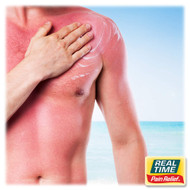Sunburn, Chafing, and Skin Irritations: Nature’s Soothing Solutions
Posted by Dennis R Escalera on 22nd Jun 2025
Introduction
Summer is a season of sunshine, beach trips, and outdoor adventures. But with all the fun comes a heightened risk of skin issues—especially sunburn, chafing, heat rash, and insect bites. These irritations, though common, can be painful and disruptive. Fortunately, nature offers a variety of time-tested ingredients that provide gentle yet effective relief through topical creams and lotions.
This article explores how summer skin irritations occur and how topical pain relief products made with nature’s ingredients may help soothe, protect, and heal the skin.
Common Summer Skin Irritations
1. Sunburn
Sunburn results from overexposure to ultraviolet (UV) radiation, leading to skin inflammation, redness, and pain. Severe cases can cause blistering, dehydration, and long-term skin damage.
- Symptoms: Redness, tenderness, peeling, swelling, heat on skin, and sometimes fever or chills.
- Risk Factors: Fair skin, lack of sunscreen, and prolonged time under direct sunlight.
According to the CDC, more than 1 in 3 U.S. adults report getting sunburned each year, highlighting the importance of sun protection and after-care.
Source:https://www.cdc.gov/skin-cancer/sun-safety/index.html
2. Chafing
Chafing occurs when skin rubs against clothing or itself, especially in areas like the inner thighs, underarms, or chest. Summer sweat increases friction and exacerbates this problem.
- Symptoms: Rawness, redness, burning sensations, or even open sores.
- Common Causes: Long walks, workouts, or ill-fitting clothing in hot weather.
3. Heat Rash (Miliaria)
Also known as “prickly heat,” this occurs when sweat glands become blocked, leading to inflammation and itchy, red bumps.
- Typical Locations: Neck, chest, groin, and elbow creases.
- Most Common In: Infants and people living in hot, humid climates.
Source: https://www.cdc.gov/niosh/heat-stress/about/illnesses.html
4. Insect Bites
Mosquitoes, flies, and ants thrive in warm weather and leave behind itchy, swollen bumps that can be painful or infected if scratched.
How Nature’s Ingredients May Help
Topical products containing nature’s ingredients offer effective, skin-friendly alternatives to synthetic chemicals. Here are some key ingredients known for relieving summer skin conditions:
1. Aloe Vera
Aloe vera gel has powerful anti-inflammatory and cooling properties, making it ideal for soothing sunburn, heat rash, and minor abrasions.
- Action: Reduces redness, moisturizes skin, promotes healing.
- Evidence: A review published in the Journal of Traditional and Complementary Medicine found that aloe vera significantly improves wound healing and reduces inflammation.
https://www.ncbi.nlm.nih.gov/pmc/articles/PMC2763764/
2. Calendula
Calendula, or marigold extract, is used to treat inflammation, dry or damaged skin, and wounds.
- Action: Antibacterial, anti-inflammatory, promotes tissue repair.
- Clinical Support: Shown to improve skin hydration and elasticity, making it valuable in treating chafed or sunburned skin.
https://pubmed.ncbi.nlm.nih.gov/37111369/
3. Chamomile
This flower is known for its gentle, calming effects on irritated skin.
- Action: Reduces redness, itching, and swelling.
- Study Results: Chamomile extract cream was found to be effective in managing eczema and dermatitis symptoms.
https://www.ncbi.nlm.nih.gov/pmc/articles/PMC2995283/
4. Menthol
Derived from peppermint, menthol provides a cooling sensation that may relieve itching, burning, and discomfort.
- Uses: Common in pain-relieving topical creams for insect bites and sunburn.
- Mechanism: Activates cold-sensitive receptors in the skin, offering a counterirritant effect.
https://pubmed.ncbi.nlm.nih.gov/36277488/
5. Witch Hazel
Witch hazel is a traditional remedy for reducing inflammation and skin irritation, especially after minor burns or insect bites.
- Benefits: Astringent properties reduce swelling, soothe itching, and cleanse broken skin.
- Dermatological Use: Often used for treating razor burn, bug bites, and heat rash.
https://pubmed.ncbi.nlm.nih.gov/36012541/
Tips for Using Topical Creams in Summer
- Apply after cleansing the skin to avoid trapping dirt or bacteria.
- Reapply as needed, especially after sweating or showering.
- Choose alcohol-free, fragrance-free formulas to avoid worsening skin irritation.
- Patch test any new product to ensure no sensitivity or allergic reaction occurs.
Prevention Tips for Summer Skin Problems
- Sun Protection: Use broad-spectrum SPF 30+ sunscreen and reapply every 2 hours.
- Stay Dry: Keep chafe-prone areas dry with moisture-wicking clothing or barrier creams.
- Cool Showers: Avoid hot water which can strip natural oils and aggravate skin.
- Hydration: Drink plenty of water to keep skin supple and resilient.
Conclusion
Summer skin irritations are not just a nuisance—they can affect your daily comfort and enjoyment. Using topical creams and lotions with nature’s ingredients provides a safe, effective way to soothe and restore your skin without relying solely on synthetic chemicals. Ingredients like aloe vera, calendula, chamomile, menthol, and witch hazel have centuries of traditional use and modern scientific backing.
Stay sun-safe, stay cool, and support your skin naturally with the help of carefully selected topical solutions.





